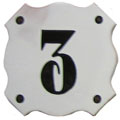NAMES and NOTICES
Click on the title to see more images Name: a word or a combination of words by which a person, place, or thing, a body or class, or any object of thought is designated, or known. (Webster’s)
Name: a word or a combination of words by which a person, place, or thing, a body or class, or any object of thought is designated, or known. (Webster’s)
Names and notices on tiles can be for houses, hotels; restaurant notices such as Private or No Entrance etc., can be made to be practical and attractive, they are painted using the Majolica Method.
The first six illustrations are designs which have a white background, a border that is part of the tile and different types of letters to give an idea of the possibilities available.
The last six illustrations are all designs specially made to order to suit individual client’s preferences.
Link to Ceramics Bensu for tiles decorated with the Majolica Method
Read more about: Architectural Ceramics / Numbers / Repeated tiles
 Neck is the part of a jar, jug or bottle that narrows at the top. It is designed to minimize the amount of liquid that can be poured out and give it an elegant shape.
Neck is the part of a jar, jug or bottle that narrows at the top. It is designed to minimize the amount of liquid that can be poured out and give it an elegant shape. Needle tools of different sizes are used for trimming pots and cleaning plate holes. Plates have two holes through the foot at the back for passing string when they are hung up.
Needle tools of different sizes are used for trimming pots and cleaning plate holes. Plates have two holes through the foot at the back for passing string when they are hung up. Numbering and coding tiles of large designs
Numbering and coding tiles of large designs Numbers for houses
Numbers for houses